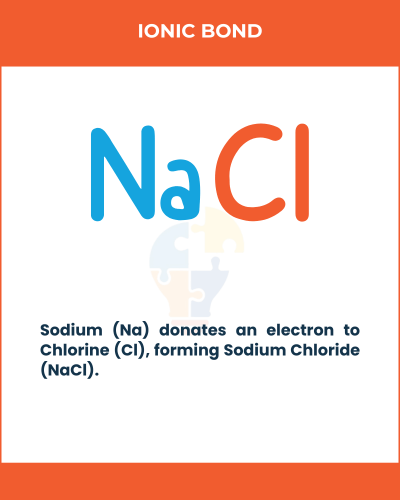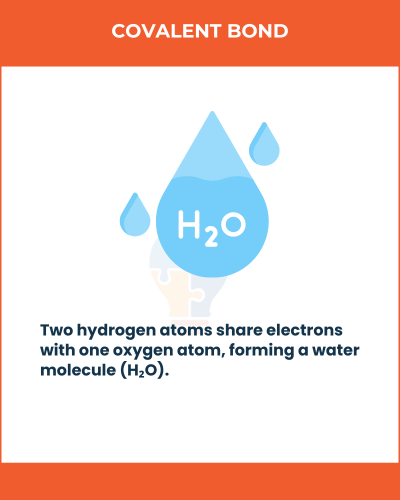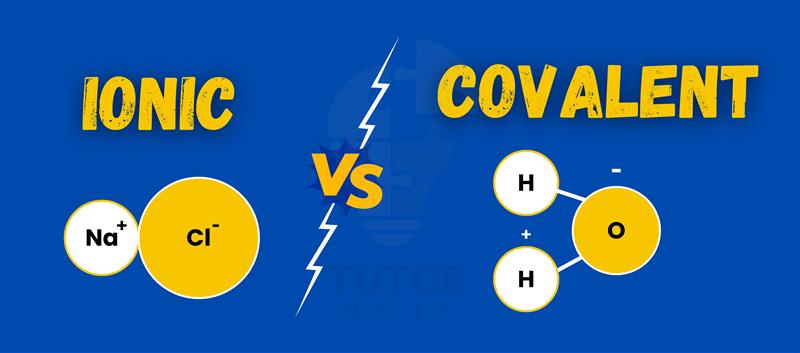Ionic and covalent bonds are important in chemistry. Ionic bonds form when atoms transfer electrons.
Covalent bonds happen when atoms share electrons. These bonds shape the materials we see around us.
Understanding these bonds is simple with the right explanation. Knowing their differences helps explain how substances are formed and how they behave.
In this blog, you will learn about difference between ionic bond and covalent bond in an easy-to-understand way. Let’s explore their definitions, examples, and key differences!
What is Ionic Bond?
"An ionic bond forms when one atom transfers electrons to another, creating oppositely charged ions."
Example,
Sodium (Na) donates an electron to Chlorine (Cl), forming Sodium Chloride (NaCl).

What is Covalent Bond?
"A covalent bond forms when two atoms share electrons to achieve stability."
Example,
Two hydrogen atoms share electrons with one oxygen atom, forming a water molecule (H₂O).

Difference between Ionic Bond and Covalent Bond
| Aspect | Ionic Bond | Covalent Bond |
|---|---|---|
| Definition | Ionic bonds form when one atom transfers electrons to another, creating oppositely charged ions. | Covalent bonds form when two atoms share electrons to achieve stability. |
| Formation | Occurs between metals (donors) and non-metals (acceptors). | Occurs between non-metal atoms. |
| Electron Sharing | No sharing; electrons are transferred. | Electrons are shared equally or unequally between atoms. |
| Type of Attraction | Strong electrostatic forces between positively and negatively charged ions. | Strong shared electron cloud binds the nuclei of atoms together. |
| State of Matter | Mostly forms crystalline solids at room temperature. | Forms gases, liquids, or solids, depending on the molecule. |
| Melting/Boiling Points | High melting and boiling points due to strong ionic bonds. | Lower melting and boiling points compared to ionic compounds. |
| Solubility | Soluble in polar solvents like water. | Solubility depends on the polarity of the molecule (polar covalent dissolve in water, non-polar don’t). |
| Electrical Conductivity | Conduct electricity when dissolved in water or molten. | Generally non-conductive, except in cases of polar covalent bonds in water. |
| Bond Strength | Strong but brittle. | Generally strong but flexible. |
| Example | Sodium chloride (NaCl): Sodium donates an electron to chlorine, forming Na⁺ and Cl⁻ ions. | Water (H₂O): Hydrogen atoms share electrons with oxygen to form covalent bonds. |
| Polarity | Highly polar, as complete transfer of electrons creates distinct charges. | Polarity depends on the difference in electronegativity of the bonded atoms. |
| Structure | Forms a rigid lattice structure in the solid state. | Forms discrete molecules with specific geometries. |
| Bond Formation Energy | Requires more energy to form and break bonds. | Requires relatively less energy to form and break bonds. |
Why Choose Tutorhelpme Chemistry Tutors
Clear Explanations: Simplify complex chemistry topics with easy-to-understand lessons.
Personalised Lessons: Tailored teaching methods to suit your learning style and pace.
Qualified Tutors: Experienced and skilled Chemistry tutors to guide you effectively.
Exam Preparation: Comprehensive support for GCSE, A-Level, and university-level exams.
Affordable Rates: Quality tutoring without stretching your budget.
Interactive Learning: Engaging online tools and resources for better understanding.
Focus on Fundamentals: Strengthen your basics for better performance in advanced topics.
Flexible Scheduling: Sessions planned to fit your busy lifestyle.
Improved Confidence: Gain skills to tackle challenging chemistry problems independently.
Read More what are bonds? types of bonds
FAQs
Is NaCl ionic or covalent?
NaCl is ionic because it forms through the transfer of electrons between sodium and chlorine, creating positive and negative ions.
Do covalent bonds exist in diamonds?
Yes, diamonds have strong covalent bonds where each carbon atom bonds with four others, forming a rigid crystal structure.
Is H₂O ionic or covalent?
H₂O is covalent because hydrogen and oxygen share electrons, forming strong polar covalent bonds that create a bent molecular shape.
Which bond is stronger, ionic or covalent?
Covalent bonds are usually stronger because they share electrons tightly, while ionic bonds rely on electrostatic attraction, which breaks more easily.

